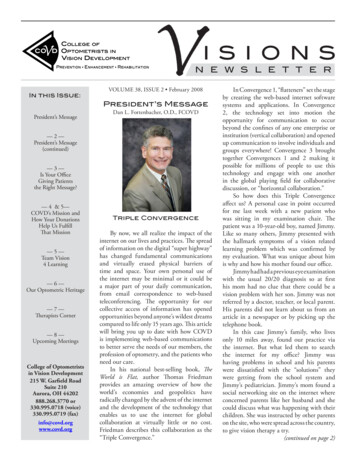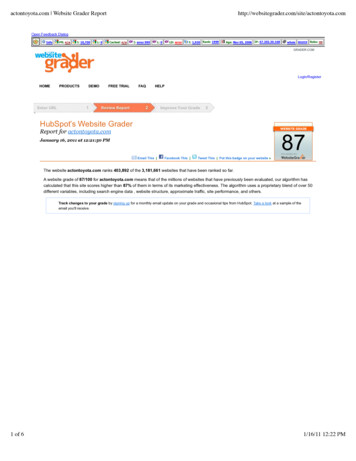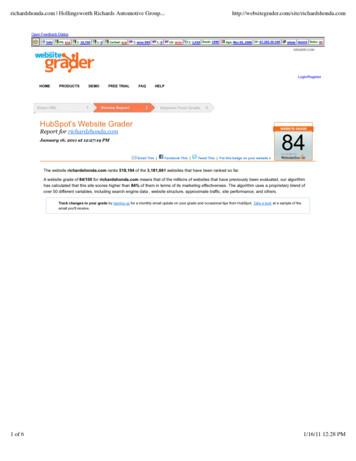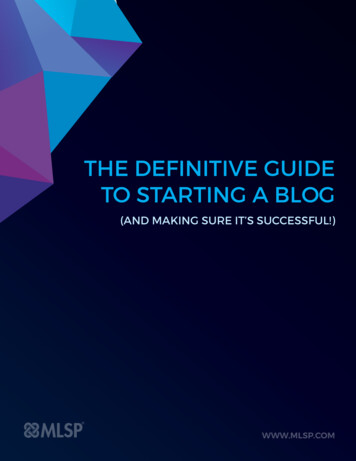
Transcription
From Blog to Book.http://newsletter.cnsa.org
2
Contents1 20081.15July . . . . . . . . . . . . . . . . . . . . . . . . . . . . . . . . . . . . . . . . . . . . . . . .5Leadership is not an Option (2008-07-12 16:09) . . . . . . . . . . . . . . . . . . . . . . . . .5Blogs – Creating Stronger Committees (2008-07-12 16:22) . . . . . . . . . . . . . . . . . . .6A Case Study on Successful Growth and Development (2008-07-12 16:56) . . . . . . . . . .8Raf’s guide in finding your dream RN job (2008-07-12 17:08) . . . . . . . . . . . . . . . . .12Just Say “No” to Stress (2008-07-12 17:19) . . . . . . . . . . . . . . . . . . . . . . . . . . . .14Nursing Students Strive to become Disaster Prepared (2008-07-12 17:28) . . . . . . . . . . .15Lights, Camera, Nursing in Action (2008-07-12 17:35) . . . . . . . . . . . . . . . . . . . . .17Striving for Excellence (2008-07-12 17:37) . . . . . . . . . . . . . . . . . . . . . . . . . . . .18Assembly Bill 2375 (2008-07-12 18:22) . . . . . . . . . . . . . . . . . . . . . . . . . . . . . .19Senate Bill 1620 (2008-07-12 18:26) . . . . . . . . . . . . . . . . . . . . . . . . . . . . . . . .19What Do Your Students Like? (2008-07-12 18:29) . . . . . . . . . . . . . . . . . . . . . . .21A Change of Mind (2008-07-12 18:32) . . . . . . . . . . . . . . . . . . . . . . . . . . . . . .22NSSI and the Power to Make a Difference (2008-07-12 18:35) . . . . . . . . . . . . . . . . .23Have We Graduated Yet? (2008-07-12 18:38) . . . . . . . . . . . . . . . . . . . . . . . . . .24University of California, Irvine (2008-07-19 00:07) . . . . . . . . . . . . . . . . . . . . . . .25Catholic Healthcare West (2008-07-25 21:05) . . . . . . . . . . . . . . . . . . . . . . . . . .263
4
Chapter 120081.1JulyLeadership is not an Option (2008-07-12 16:09)(If you’re wearing the skis, you’re a skier)ANA/C Contribuion. Susan Bowman, Ph.D., RN., Professor Emeritus, Humboldt State UniversityIf a person puts on a pair of skis and goes downhill on a snowyslope, that person is askier. Being a skier is not an option in that situation. They may be novices or experts but they arestill skiers. Skiers may choose to ski on the same slope throughout their whole life and get to bebetter and better at skiing on that slope. On the other hand, he/she may try other slopes at otherski areas and become a better skier on more difficult trails and, of course, also be able to ski theoriginal slope with more skill.To be a nurse is to be a leader. The nurse assumes a leadership role in any professionalnurse-patient relationship regardless of the practice setting. Although leadership is not an optionin your chosen career, how you lead and whom you lead are both options. Your leadership skillsmay remain focused on direct patient care throughout your career and you will assume a moreand more skilled leadership role in the nurse-patient relationship. On the other hand, you maychoose to be a leader among your peers within the agency where you work or through a nursingorganization. You may choose to demonstrate leadership as a representative of nursing on aninterdisciplinary committee or in the legislative, political, or policy arena. Every time you choose5
to develop your leadership skills in a new situation, you enhance those leadership skillsapplicable to direct patient care and become a better leader in nursing practice as well.I encourage you to seek out opportunities to develop leadership skills in many differentsettings. Just as the ski trails are marked for you to know which ones are for beginners,intermediates and experts, so are the leadership opportunities in nursing. As a student, you canseek out opportunities at your local school chapter or run for an office or director position inCNSA. There are committees at your school that need student representation, too. When youbecome a registered nurse, it will be obvious to you that you are not ready to seek out thepresidency of the International Congress of Nursing in your first year of practice, however, youcan become a member of the American Nurses’ Association of California and become active in achapter, committee, or task force. You can also attend conferences related to your chosenspecialty and prepare a poster or paper to present with a colleague or mentor.Don’t shy away from any opportunity to develop your leadership skills. In fact, seek themout. Don’t worry about being a novice and finding yourself on an expert slope that was notmarked correctly. It’s not the best approach to gaining experience but it can happen. That hashappened to me in both skiing and in nursing. In those instances there was an expert skier or anexpert nurse to help me down those steep slopes that I found myself on and I learned about betterways to gather important information necessary in both nursing leadership and skiing.You don’t have to be president of an organization to be a leader. You don’t need to have atitle like “nurse manager” or “supervisor” to be a leader. You will learn (or have already learned)in your nursing leadership course about styles of leadership, characteristics of leaders, definitionsof leadership, etc. However, just as you already know that reading about different skills andsituations in nursing is not the same as being the nurse (or student nurse) in that nurse-patientsituation, so is reading about leadership not the same thing as gaining first-hand practice indeveloping those skills. It is never too soon to begin being aware of how you facilitate thingsgetting done, how you motivate other people, how your ideas are presented and received, etc.Leadership is not an option when you are in nursing, so begin seeking out opportunities to learnand practice leadership skills.Blogs – Creating Stronger Committees (2008-07-12 16:22)Breakthrough to Nursing. Trina Eagal, San Joaquin Delta CollegeWhat is a blog?A blog, short for “Web Log”, is an easily accessible webpage where comments are left andresponded to for all those who go to the website to view.WHO is the blog designed for?The blog is mainly designed for those interested in joining the Board Member’s committee, butall those interested in activities associated with that position are encouraged to view the site and6
leave comments and ideas.WHAT can I share on the blog?You can share ideas, comments, questions, pictures and anything else you feel is worthwhile.The blog is meant to allow committee members and interested parties to see what the CNSABoard Members are hoping to accomplish or are accomplishing during their term and to get andshare ideas about your own chapter.WHEN can I access the blog?NOW! Board Members will periodically check their blog to see if new posts or comments havebeen left. For a more immediate response, email the Board Member.WHERE do I go to see the Board Members’ blogs?President, Jim Edmunds [1]http://cnsapresident.blogspot.comVice President, Brandy Azevedo [2]http://cnsavp.blogspot.comLegislative Director, Ian St. Martin [3]http://cnsalegislation.blogspot.comCommunity Health Director, Kelley Stewart on Director, Megan Munz [5]http://cnsaconvention.blogspot.comBreakthrough to Nursing Director, Trina Eagal ary, April Simoni [7]http://cnsasecretary.blogspot.comCommunications Director [8]http://cnsacommunication.blogspot.comChapter of Council Reps - North, Rafael Ramos [9]http://cnsacocrsouth.blogspot.comChapter of Council Reps - South, Shiloh Cooper [10]http://cnsacocrnorth.blogspot.comAd Hoc Image of Nursing Committee, Judy Chang [11]http://cnsaimageofnursing.blogspot.comWHY should I access the blog?Just as you are interested in the Boards’ ideas and activities, we are interested in your chapter’sideas and activities as well. Help us create a strong and productive committee by giving us yourinput.HOW do I gain access to the blog?Anybody can view the blog, but in order to become an author and post comments and ideas, youwill need to be “invited”. This can be done by contacting the Blog’s representing BoardMember.1. http://cnsapresident.blogspot.com/2. http://cnsapresident.blogspot.com/3. http://cnsalegislation.blogspot.com/4. http://cnsacommunityhealth.blogspot.com/5. http://cnsaconvention.blogspot.com/6. http://breakthroughtonursing.blogspot.com/7. http://cnsasecretary.blogspot.com/8. http://cnsacommunication.blogspot.com/9. http://cnsacocrsouth.blogspot.com/10. http://cnsacocrnorth.blogspot.com/11. http://cnsacocrnorth.blogspot.com/7
A Case Study on Successful Growth and Development (2008-07-12 16:56)Chapter Contribution. Lisa Chong, California State University, Long BeachAs nursing students, we are familiar with case studyassignments. Hypothetical patients with complex conditions are presented, and we are expected to use ourcritical thinking skills to assess the needs of the patient, as well as create nursing plans and interventions toimprove their physical and psychosocial wellbeing. Similarly, as CNSA members, we can consider ourselvesas one patient - we are part of a dynamic organization that also has complex components and requires thesame focused attention and plan for optimal health.Assessing the needs of an organization, and furthermore, creating a plan with viable actions can bea seemingly daunting task inciting numerous questions. Where do we begin? How can we achieve our goals?How do we recruit and keep our members? These are questions our CSULB CNSA board members embracedthis past year, and through trial-and-error, we have developed a healthy organization that has providednumerous resources for our members. We are proud to have recently been chosen as ”Organization of theYear” by CSULB’s College of Health and Human Services, but we are also very much and humbly aware ofthe constant need for re-assessment and planning. We extend our hand to your CNSA Chapter and hopethat you find the following tips valuable and helpful.Creating a Mission StatementAlthough creating a mission statement may seem unnecessary or a waste of time, a well thought out andfocused statement lends to a specific identity and purpose-oriented organization. At our very first boardmeeting, we collectively created our mission statement for the upcoming school year. This statementintimately tied to what each of us believed should characterize our board’s identity and what we wantedCNSA to achieve. After careful consideration and productive discussion, we agreed our mission was ”to fosternursing education, facilitate early unity among our future colleagues in nursing, and to optimize the nursingstudent’s exposure to the numerous specialties and pathways in the ever-changing field of nursing.” Ourfaculty adviser, Dr. Jarline Ketola, facilitated this process by challenging each board member to first comewith our own goals for CNSA. From there, we used a white board and grouped these goals into related topicsand began discussing the ones we felt were most important.While we wanted to change numerous aspects about our chapter, in order to effectively start theprogression of change we had to focus our attention to a select few projects. The combined effort from ourboard, faculty and CNSA members allowed us to regain our status as an important part of the nursing8
program and as a connection between students, faculty and the nursing curriculum.Alissa Miyake, Vice-President & Public Relations Director, CSULB CNSA 2007-2008Goals need to reflect the reasons that most members have for joining a group. In this way, members remain passionate about the group because they are doing what they think is important. It is thereforeessential that all members, especially the shy ones, have an active voice in setting the goals. One way to dothis is to have members write 3 goals, each one on a different card. Volunteers from the group paste all thecards on the wall. The goals that have the most cards become the goals for the group.- Dr. Jarline Ketola, Faculty Advisor to CNSAIncreasing Membership (Quantity & Quality)One way we increased membership was by establishing a strong first relationship with incoming nursingstudents at our New Student Orientation. By working with our faculty member, Dianne Leever, who isin charge of the orientation program, we spoke to the new students about CNSA and the various eventswe offer and activities they can participate in. Our board members created a PowerPoint presentation tovisually organize the information and spoke about the different resources we provide new nursing students tosmoothly transition into a rigorous academic program. Resources like our Careplan Workshop and CareerFair are a few examples we highlighted.Another way we planned to increase membership was by borrowing a great idea from Golden WestCollege’s CNSA. During the most recent CNSA conference, GWC’s members shared that during the newstudent orientation, they would have laptop computers already linked to the NSNA website so that studentscould immediately also sign up for the mandatory national membership. This process alleviated a concernregarding how to confirm CNSA members had satisfied the mandatory NSNA membership. With our mostrecent new student orientation in June 2008, however, we quickly realized that one laptop was not enough toaccommodate the long line of 70 to-be CNSA members! Thus, one lesson we learned is to plan for multiplelaptops to account for long lines or slow internet connections.One way we hoped to retain CNSA membership is by continually re-assessing the needs and desiresof our current members. For example, surveys have been a great way to identify what kinds of nursingspecialties our members are interested in. Related to our mission statement goal, we provided monthlyseminar meetings where various nursing speakers would come and speak to us about their specialty or focus.We used the information from these surveys to direct our speaker selection and scheduling.Getting people to part with money is never an easy task, especially when you are asking studentswith academic loans or strict budgets for 35 membership fees. However, by having class representativesspeak in their nursing classes about the benefits of CNSA and NSNA membership, it gives potential membersan incentive to join, as well as provide a face-to-face link to the organization.April Kubachka, N200 Class Representative, CSULB CNSA 2007-2008; Vice-President & President-elect,CSULB CNSA 2008-2009In the past, CNSA speaker meetings have drawn just four to five students/meeting. The 2007-2008CNSA CSULB focused on promoting speaker meetings. We asked our nursing faculty to include our flyersin their lecture PowerPoint presentations, the class reps spoke to their classes bi-weekly about upcomingevents, and we hung banners at the nursing building, announcing upcoming meetings. Another way wedrew more students was, after analyzing the semester schedule for our 600 nursing students, to schedulemeetings when the most students were on campus, and over the lunch hour. We supplied pizza and soda tothe students, and recruited charismatic nursing speakers from specialties that were of interest to our them.From the first to the last speaker meetings that the 2007-2008 CNSA CSULB board conducted, our studentattendance averaged 80 students/meeting.9
Amanda Severson, President, CNSA CSULB 2008-2009Careplan WorkshopBecause careplans have traditionally been the bane of every nursing student’s existence, our board organizeda Careplan Workshop for new students.As a first semester student, I felt as though I was drowning. I went from entering the nursing program with a 3.7 GPA to receiving D’s and F’s. I knew I needed help, and CNSA was the one to throw me alife preserver. A few of the senior members took me under their wings and shared their collective knowledgewith me. One suggested holding a workshop, where senior CNSA members could help new students with thehardest part of their first semester - the dreaded, all-consuming patient careplans. I helped get the idea offthe ground, as I knew any information from these cream-of-the-crop senior students would help us greenstudents tremendously. And it did.The senior students taught us time-savings techniques for careplanning nights, how to approachnursing staff at hospitals, and also shared online resources for labs and nursing diagnoses. Most importantly,they gave us a much-needed pep talk, which boosted our morale considerably. The feedback from the 40students who attended the workshop was overwhelmingly positive, and on a personal note, it helped me passmy classes, which I was thrilled about! It also made me feel good to know that as a first-semester CNSA classrepresentative, I had a part in helping my fellow students navigate the hardest semester of nursing school.April Kubachka, N200 Class Representative, CSULB CNSA 2007-2008; Vice-President & President-elect,CSULB CNSA 2008-2009Stronger Faculty-Student RelationshipsOur nursing department faculty convenes on a monthly basis, and Amanda Severson, the CSULB CNSAPresident 2007-2008, attended these meetings to represent our organization. She provided updates on whatcurrent projects our chapter was working on, and she provided different ways that the faculty could supporttheir students or work with CNSA through these activities. With her representation, a strong faculty-studentrelationship gradually blossomed and extended to numerous faculty members becoming increasingly involvedwith CNSA events and vice-versa.For example, one of our nursing department staff members, Maureen ”Mo” Bykerk, has been actively involved with arthritis awareness through the Arthritis Walk as her 8 year-old niece Caitlin is diagnosedwith systemic juvenile rheumatoid arthritis. Our Community Service Director, Tina Thomas, organized aCNSA group to join Mo’s Arthritis Walk group to help raise money and awareness. Several faculty membersincluding Melody Coffey-Love, Anita Fitzgerald, and Silvia Walker supported CNSA’s Arthritis Walk groupby challenging their students to raise money for the cause. With their support as well as many others, Mo’sArthritis Walk group exceeded their goal and raised over 30,000!Many of other faculty members have continually supported student participation by chiming inwhen our representatives make announcements during class. One of the associate professors, BeckyDahlen, even donated brand new textbooks to the Career Fair raffle after our ELM representative made anannouncement about the event during class.The CNSA Board members were enthusiastic, reliable and very competent. The faculty valuedtheir ability to accurately represent the students, their ability to communicate with and for their colleaguesand their ability to further the goals of the faculty by competently teaching subjects such as careplans andparts of the orientation program. In this way, the CNSA Board members endeared themselves to the facultyand gained their respect and trust.- Dr. Jarline Ketola, CNSA Faculty Advisor10
Community InvolvementOur organization became involved within the community at a variety of levels. The CSULB College of Healthand Human Services (CHHS) held monthly meetings for a variety of organizations, and Christina ”Tino”Tolentino, our N300 Class Representative, was the CNSA representative on the CHHS’s Student Council.As our liaison, Tino provided a means of potential collaboration with other health-oriented organization something we hope to do more of in the future.CNSA also became involved within the larger CSULB setting by participating in the annual Kaleidoscope Festival, an ”open house” event for the local college and surrounding area. We borrowed our nursingdepartment’s Simulation Man to attract passersby of the various technologies our program has to offer,as well as providing information about the nursing program to interested parties. At this event, we alsoprovided free blood pressure readings.It was here that I was able to collaborate with different students from other organizations withinour college. We would discuss and vote on issues that would be brought up to the University’s AcademicSenate. More importantly I was able to give reports about CNSA to other organizations. At the end of theyear I nominated us for organization of the year and presented a PowerPoint on CNSA. Although there weremany other deserving and hardworking organizations, we were so happy to found out we had won! After allof our hardwork with raising membership, uniting the faculty and students together, and having the abilityto mentor our fellow nursing students, we were voted the organization of the year within the College ofHealth and Human Services for CSULB. I could not be more proud to be apart of such an amazing board offuture nurses. :)Christina ”Tino” Tolentino, N300 Class Representative, CSULB CNSA 2007-2008; Community ServiceDirector, CSULB CNSA 2008-2009Career FairOur board recognized the importance of revitalizing the annual nursing career fair for our campus. Careerfairs allow nursing students at all levels of the nursing program to explore positions for student technicians orCNAs while in school and as registered nurses once they graduate. Students are also allowed to practiceinterviewing skills in a non-threatening environment. For this year’s career fair we redesigned our advertisingefforts, inviting over 50 Los Angeles and Orange County hospitals and over 35 local nursing schools.The response we received was refreshing. We had to decline applications from various hospitals,since we had reached our maximum capacity for 23 tables in our nursing department courtyard. Over 130students attended the career fair; students who were still taking prerequisite classes to get into the nursingprogram to students as far away as East Los Angeles College attended. Making the extra effort to improveour organizing and advertising skills not only brought about a successful event, but proved to be a greatresource for nursing students, which was more than enough validation for all our hard work.Alissa Miyake, Vice-President & Public Relations Director, CSULB CNSA 2007-2008All Great Things Do NOT Have to Come to an End: Tips On Fostering Your Local Chapter’sCNSA Involvement and MembershipCommitmentDevelop a mission statement to define your chapter’s purpose and then formulate key goals that you want toaccomplish throughout the school year.Communication11
Attend faculty meetings and provide updates on what your CNSA chapter is doing, as well as how the facultycan support or work with your organization.Create surveys and have class representatives pass them out to learn what nursing topics your members wantto hear about.Embrace new modes of communication technology by creating a website and/or a MySpace or Facebookpage, as well as emailing members about important upcoming events.CareerOrganize a career fair by inviting local hospitals and/or other potential employers so that members can getan idea of what new graduate RN programs are available.Schedule a mock interview seminar with former CNSA members who have recently gone throughthe hiring process and have their own tips.Plan a résumé-writing seminar. Many colleges have career centers that are great resources, and local hospital human resource/hiring departments are often willing to provide tips on interviews, résumés, etc.as well.CamaraderieMaintain a sense of friendship and trust within the board, organization, and nursing department by involvingfaculty and students in supporting your ”home” causes e.g. our staff member’s Arthritis Walk group.CommunityBecome involved in your college-wide fairs by providing free blood pressure readings and provide informationabout your specific nursing program to interested parties. Connect with other organizations and studentcouncils for updates and collaboration ideas.ClothingDesign apparel like sweatshirts to instill CNSA membership and nurse pride; this can also possibly be asuccessful fundraiser.Encourage senior nursing students to donate their ”gently used” uniforms to incoming students, andprovide the former group incentives like discount off membership fees, etc.CelebrateBe generous to yourselves - Most groups invest time and energy to help others. To do this well, especiallyover time, you must find ways to replenish your energy. Be generous to yourselves. After a successful eventthat took hours of effort, go out to dinner using your treasury funds to celebrate. Add food to your meetings.Your group efforts will benefit from this generosity. Dr. Jarline KetolaRaf ’s guide in finding your dream RN job (2008-07-12 17:08)COCR- North. Rafael Ramos, San Francisco State University12
If you have read our previous issue, you might have noticedhow I explored the narrowing nursing shortage in Bay Area. Now, this does not mean that this holds true inother areas of the country, especially in suburban and rural California. In fact, we still need 30,000 RNs peryear to meet our health care needs, according to research done by the Council on Physician and Nurse Studylast March 2008. However, if you would like to do your New Graduate Training Program and eventually workon a specialty unit such as a Cardiovascular ICU, Emergency Room, Pediatric ICU or a Hematology/OncologyUnit and not just a typicalMedical-Surgical floor (not that this is bad), you should not assume that just because of this shortage thatyou will get the clinical placement or land your dream RN job. Remember: it is extremely vital for one to bealways vigilant, resourceful, and assertive.We all know how our clinical instructors work tirelessly in finding us our clinicalplacements. We also know that part of this nursing shortage stems from the fact that there aren’tthat many clinical placements available. But what would you do if during your last semester ofnursing school they place you on a unit where you don’t want to do your preceptorship?Moreover, work on a unit 3 months after getting hired and realize that you don’t want to be there?Essentially, you’re in big trouble! But wait, this is not going to happen because you willremember this article and put it to heart. . . . .Some things one may want to consider. . .1. Connections, Connections, Connections. I’ve often told this to my friends and this doesn’t onlyapply to nursing but pretty much to any type of work, especially when one is a novice or a NewGraduate. It is important for one to know the right people. Find out who your Clinical PlacementCoordinator is at your school. Ask him/her about the Nurse Educator of the hospital and unit youare interested in working. Introduce yourself and get your name out there by e mailing, calling,or writing a letter.2. Open Houses. Do your research. Look over the web for any open houses and job fairs. Mosthospitals participate in these events. Attend as many open houses as you can. Remember: Bringyour resume, look professional, organize your files, and be prepared for an on-the-spot interview.3. Work in the hospital. Get your feet wet! Do a part time or a per diem job in a hospital as anursing assistant, unit secretary, EKG Tech, etc. This will be valuable to you as a nursing student13
and will set you apart from the rest of your classmates. You learn more about the variousprofessionals and their roles in the hospitals i.e. RNs, MDs, RTs, PTs, Technicians, etc.Moreover, you will be able to interact with clients and enhance your communication skills.4. Apply for internships. Search online and ask your clinical instructors or faculty about availablesummer internship opportunities. This will enable you to have more bedside experience andeventually make you a more competent and confident nurse. (Plus it is often paid, too!)5. Find a mentor. Throughout your life and student career, it is important to look up to somebodyand serve as your role model; someone who you want to be like someday in the future. Thiscan be a teacher, co-worker, employer, family member, friend, or a fictitious being. To do this,you must first determine what qualities that person has that you would like to emulate.At this point you must be wondering what are my qualifications as a writer for putting allthis together; if these suggestions are feasible, will they work and help you to eventually landyour dream job as a nurse? Well, I would not say that I am an expert but, I can tell you that I usedall these and they have produced positive outcomes for me.Starting nursing school, I didn’t have any prior healthcare experience at all. I did notknow anybody. I attended a career fair and got a job at Stanford Hospital as a nursing assistant,made lasting friendships, and gained several mentors in the process that have taught me valuablelessons in life and how to succeed in nursing. I also applied and got accepted at a competitivesummer nursing internship at UCSF. Because of my work ethic and appealing personality(ahem!) they offered me a job as a Per-Diem nursing assistant. I did all these while I was innursing school. Just this May 2008, I’ve finally graduated with a Bachelors of Science inNursing and a Minor in Health Education. Because of the five aforementioned things that I didduring my entire student nursing career, the fruits of my labor paid off as I was offered a NewGraduate position at a Cardiovascular ICU at Stanford Hospital and am starting on July!Just Say “No” to Stress (2008-07-12 17:19)Council of Chapter Representatives, South. Shiloh Cooper, Santa Ana CollegeWhen school is out for the summer, stress is probably the lastthing on our minds. The first thing would probably be getting a tan, surfing, or going on vacation somewhereaffordable. It’s very important to master these stress reducing techniques when our stress levels are low, sothat when the stress levels increase we’ll have a better chance of reducing them. We have all learned to teachpatients to ask for pain medications when the pain isn’t too severe, because it’s easier to control the pain if14
caught early. The same concept
Nursing Students Strive to become Disaster Prepared (2008-07-12 17:28). . . . . . . . . . . 15 . seek out opportunities at your local school chapter or run for an o ce or director position in . Vice-President & Public Relations Director, CSULB CNSA 2007-2008 Goals need to re ect the reasons that most members have for joining a group. In .











